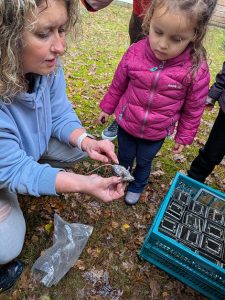Around 65 people participated in our conference (a small number joined online from Canada and Slovakia). Participants came from Belgium, Germany, England, and the Netherlands. Quite a few members turned out to be on vacation, which meant we had fewer participants than expected. We will approach this differently in 2026. We asked both the participants of this conference, our members, and the public which dates they prefer.
This year, we again organised a multi-day members’ conference. The first guests arrived on Friday afternoon. We had a shared dinner, after which everyone could continue chatting in the lounge at their leisure. On Saturday we started at 9 a.m. and the programme ended around 4 p.m. Of course, we had arranged stroopwafels again. At 6:30 p.m. we had our dinner.
Again this year, we were in the fortunate position to be able to pay for a hotel room for each family/participant, so that the threshold to stay for the whole weekend — including Saturday evening — was as low as possible. The Sunday morning programme took place in the nature area around the conference centre.
New: together with Naevus Network NL
This year, we organised our members’ conference together with Nevus Netwerk Nederland (NNN). It turns out that we often invite the same speakers and that we even share certain similarities in the field of genetics. In addition, we have developed informational materials together, such as the ‘Parent Support Guide’ and ‘Living Loss’. Some sessions will be specific to each organisation, such as the members’ meeting, but other sessions — like the one by Dr. Willemijn Bos — can be held jointly. Furthermore, participants from both organisations can take part in the creative and other sessions.
Members' conference and other discussed items
As chairman of the CMTC-OVM organisation, Lex opened the conference. This year, we split the ‘formal’ part into a short introduction and the organisational accountability section.
The introduction consisted of a welcome and an overview of the weekend.
The minutes of the previous members’ conference were approved. Then the financial data and the positive findings of the Audit Committee were presented, after which the attendees granted discharge to the treasurer for the 2024 financial year. The minimum membership fee for 2026 has been reduced from €35 to €25. The reason for this is that we want to keep the threshold as low as possible, so that we can help as many people as possible, especially in countries where incomes are relatively low.
The budget for 2026 was presented, noting that we have submitted a grant application to the Ministry of Health, Welfare and Sport (VWS). The maximum institutional subsidy now amounts to €80,985! This gives us the opportunity to organise many activities again, including three events in 2026.
The following points were discussed:
The Complaints Committee has not received any complaints.
Overview of the main activities carried out in 2024. An impressive list!
Planned activities for 2026. Thanks to the additional subsidy, there will be even more activities!
Budget 2026.
Our planned, ongoing, and completed projects.
Video interviews. These have already been viewed thousands of times. During our 2023 members’ conference, we recorded for the first time a series of video interviews which are on our website with subtitles in multiple languages. We interviewed patients, parents, and doctors. During the 2024 and 2025 members’ conferences, we recorded another series of video interviews.
We established a CMTC-OVM Activities Team (CAT) in 2025. Would you like to participate, for example, in organising events? Then get in touch with us.
Presentation Lex van der Heijden
Deze content is alleen beschikbaar voor leden.
This content is only available for members.
Presentation Dr. Bibi van Montfrans & Dr. Jorie Versmissen (NL) - Vascular malformations
Dr. Bibi van Montfrans is a dermatologist, and Dr. Jorie Versmissen is an internist at the Erasmus Medical Center in Rotterdam.
Presentation summary
Vascular malformations – what they are and why care is important
Vascular malformations are abnormalities in the blood vessels that are present from birth. They can grow or change over the course of life. The correct diagnosis is made using the ISSVA classification, an international system for categorising vascular malformations.
⚕️ Impact on daily life
Research in nearly 700 patients shows that people with vascular malformations experience more pain and mental stress than the general population. Therefore, psychosocial support is an important part of treatment.
🔬 Diagnosis and genetics
Some vascular malformations are associated with genetic mutations, such as:
PTEN mutation (PTEN Hamartoma Tumor Syndrome)
GNAQ mutation
If a hereditary syndrome is suspected or medication is needed, genetic testing is carried out.
💊 Treatment
Treatment depends on symptoms such as:
Bleeding
Pain
Clotting problems
Cosmetic or functional issues
Infections
Involvement of organs or bones
Possible treatment options include:
Medication (e.g., Sirolimus, an mTOR inhibitor):
Inhibits excessive growth of vascular cells
Reduces inflammation
Helps stabilize the blood vessels
Does not eliminate the malformation, but reduces symptoms
Pain management and anticoagulation, often in consultation with a pain team
Possible side effects of medication include: reduced immunity, mouth inflammation, and lipid metabolism disorders. Medication levels are carefully monitored.
👩⚕️ Care at Erasmus MC
Multidisciplinary team (weekly meetings): dermatologists, internists, paediatricians, radiologists, psychologists, etc.
Paediatric and transition clinics: for transitioning from child to adult care
Recognised national expertise centre (part of VASCERN-VASCA)
Contact: wevar@erasmusmc.nl
💡 Key points (“Takeaways”)
Diagnose as early as possible
Use a multidisciplinary approach
Treat in a timely manner to prevent complications and psychological issues
Conduct genetic testing when hereditary syndromes are suspected or medication is needed
Mental health is as important as physical treatment
Presentation Dr. Willemijn Bos - Four layer skin model
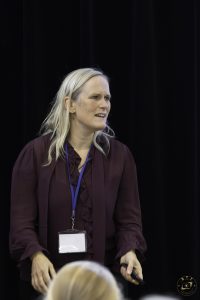
After nearly 10 years working as a dermatologist, she felt it was time for a new phase. Through a combination of mind-body coaching, lifestyle training, and energy medicine, she personally experienced how releasing unconscious emotions, adjusting lifestyle habits, and exploring her shadow aspects can lead to transformation. What a liberation to finally reach the layers where true change occurs! As a result, both her personal life and her work as a dermatologist became much more in flow.
With this knowledge and personal experience, she was able, in her work with dermatology patients, to explore the underlying layers where the root of their skin problems resided. She also began supporting people who were “not feeling well in themselves.”
Today, she guides everyone willing to look deeper into what is happening beneath the surface, with attention and time.
Presentation Summary
The skin contains blood vessels in the dermis, the sensory layer of the skin.
If a capillary malformation is present in the blood vessels, it can influence your emotions.
These emotions can be linked to thoughts: neutral, positive, or negative.
The epidermis (outer layer) symbolizes the layer of thoughts in the skin.
A person with a capillary malformation may have a thought such as: “I want something different.”
There may also be conscious or unconscious emotions present, such as sadness or irritation.
Feeling through these emotions can lead to calm and acceptance.
After processing emotions, new thoughts can arise that are neutral or positively charged.
Positive thoughts and neutralized emotions can provide energy as a foundation. The subcutaneous fat layer symbolizes your energy.
By examining the symbolism of the skin layers, insight can be gained into the impact of variations in the skin.
Presentation Matt Bolz-Johnson - Mental health toolkit
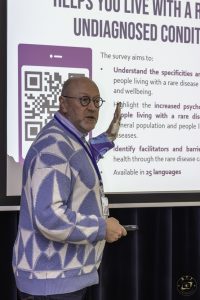
Within EURORDIS, Matt has led advocacy work for the rare disease community by shaping the development and implementation of the European Reference Networks (ERNs).
Specifically, Matt has ensured that a patient-centered approach is central within the ERNs by establishing European Patient Advocacy Groups, which are formally linked to each ERN.
In addition, Matt leads advocacy work in the field of mental health and the development of a new EURORDIS network for Mental Wellbeing Partnerships.
Presentation summary
At the CMTC-OVM Members Conference on 25 October 2025, the session “The Importance of Quality of Life and Mental Health Toolkit in Rare Conditions” explored how mental health is a vital yet often overlooked aspect of living with a rare disease.
Mental health is not simply the absence of illness, but the ability to cope with life’s challenges, learn, work, build relationships, and find purpose and joy. It is a fundamental human right and an essential part of overall well-being. Everyone experiences mental health differently, and it naturally fluctuates with life’s circumstances and emotions. For people affected by rare conditions, safeguarding mental health and wellbeing can be particularly challenging. Protective factors such as access to accurate information, community support, and good physical health strengthen resilience, while isolation, stigma, financial stress, and fragmented care increase vulnerability. Because rare diseases are often poorly understood, individuals frequently face greater risks linked to inequality, uncertainty, and a lack of coordinated support.
Living with a rare condition can be emotionally and physically exhausting. Many people experience long and frustrating diagnostic journeys, with frequent misdiagnoses and limited access to reliable information. The constant uncertainty and complex mix of symptoms place strain on both patients and families. Research shows that 90% of people living with a rare disease report feeling anxious, stressed, or depressed, whilst some people experienced suicidal thoughts. Yet only around half receive adequate psychological care, a clear sign that mental health support needs to be fully integrated into the care pathway.
Good communication by healthcare professionals can make a profound difference. When professionals listen actively, use clear and compassionate language, and acknowledge emotions and uncertainty, families feel heard and more in control. Pthe should take responsibility of the uncertaint a diagnosis of a rare condition brings and not hand this over to the families. Providing information gradually and offering follow-up support helps families navigate their journey with greater confidence and trust.
Stigma and social isolation remain powerful challenges. Many people with rare conditions feel unheard or misunderstood, often needing to explain themselves repeatedly, which is an exhausting and alienating experience. Rebuilding a positive sense of identity becomes especially important during key life transitions, such as adolescence or early adulthood.
Families also carry much of the emotional and practical pressures. Parents often face difficult decisions and challenges in communicating about the condition. Siblings may feel overlooked or anxious about the future, while partners provide crucial emotional support but may need help themselves. A healthy family dynamic, where everyone’s emotional needs are recognized and supported, is one of the strongest predictors of quality of life. Mental health at its core is simply about the quality of the relationships with have in our lives. Safeguarding our closest relationships has a direct impact on improving quality of life of those living with a rare condition.
There is a growing recognition of the need for enhance medical care to be psychologically informed, to care for both the physical symptoms as well as the wellbeing of the family. This means embedding empathy in every medical interaction, involving psychologists and social workers in multidisciplinary teams, assessing families abaility to cope and their support system and resources, throughout diagnosis and treatment, and strengthening resilience in both patients and families.
To support this shift, EURORDIS has, supported by patient support groups including CMTC-OVM, in developing a Mental Health Toolkit. The toolkit is a practical resource designed to promote emotional well-being and empower people living with rare condition, along with their caregivers and families. It brings together evidence-based strategies and existing tools to help the rare disease community build resilience, find balance, and live well.
Ultimately, the message from the session was clear: mental health is just as important as physical health. To truly improve quality of life, care must address not only the body, but also the mind, the family, and the community, helping everyone affected by a rare condition to live with strength, dignity, and hope.
Workshops
Workshop 'stacking ring'
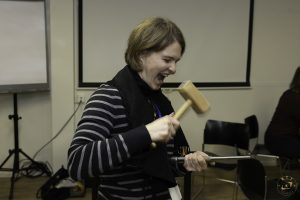
Workshop 'Ugly Christmas Sweater'

Workshop 'Graffiti'
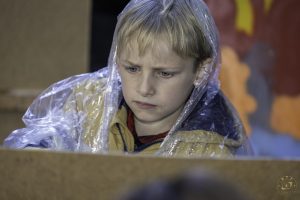
 Photoshoot
Photoshoot
The photoshoot was open to both Naevus Network and CMTC-OVM participants. You could be photographed alone, with family, or with birds and cosplayers. The backgrounds of the photos were edited afterward if desired.
In the photo album below, you can get an impression of this activity.
COSPlayers

The word cosplay comes from “costume play.” Cosplayers often make or buy their own costumes and try to resemble the chosen character as closely as possible – including clothing, hairstyle, makeup, and accessories.
The cosplayers present at the event were from Star Wars.
In the photo album below, you can get an impression of this activity
Birds
The organization Uiltopia was present with several birds. One of the guides was dressed as a character from Harry Potter. You could not only be photographed with a bird, but you could even have a bird on the photo!
In the photo album below, you can get an impression of this activity.
Massage
The chair massage was a success again this year!
Both adults and children (including entire families) took advantage of this free chair massage. Our masseur was able to give many people, both children and adults, a wonderful massage.
Interviews
On our website, we not only share personal stories in text but also have a blog aimed at sharing personal experiences. Nowadays, creating video interviews is a great way to share personal experiences in multiple languages.
We have recorded interviews with people who have a vascular condition, including both adults and children, parents of a child with a vascular condition, and healthcare professionals. These interviews were recorded in the native language of the interviewee and will be published on our website with subtitles in multiple languages.
Musical performance Elwin & Nienke Lentze

Living Loss: A story about living with a very rare condition
When we—Elwin and Nienke—were preparing for the arrival of our daughter, nothing could have prepared us for the turn our lives would take. The pregnancy went smoothly, and we were looking forward to a bright future together as a family. But our dream changed abruptly when our daughter, not even a day old, suddenly stopped breathing. The doctors were in a panic, searching for answers that seemed unavailable at the time. We waited through the night in uncertainty, until we finally heard that she was still alive. The diagnosis, which came only after a long search, was a rare condition: Alternating Hemiplegia of Childhood (AHC).
This diagnosis brought us into a world where limitations became the new normal. Everyday life, which seems so natural to others, became a constant challenge for our family. Things like outings, vacations, and even a simple car trip now required extensive planning and preparation. Our relationship was also tested, as caring for our child sometimes pushed us to our limits.
Yet this situation also brought unexpected positive influences into our lives. Our perspective on life changed, and we learned to value moments of connection and support. We met people willing to help and think along with us. Together with other parents of children with the same condition, we work on solutions and share hope. The connection with fellow parents has given us strength and shown us that we are not alone.
Our journey with AHC is a story of “Living Loss,” but also of rediscovery and growth. It is a story of cherishing small victories, learning from each day, and finding strength in love and community.
It was a privilege to share this story during the CMTC-OVM international members’ conference in Leusden. For me (Elwin), as a musician, it was even more meaningful to support the story with fitting songs and perform them live. Of course, my personal song “One in a Million,” about the worries and fears—but above all about the love for my daughter—was not to be missed.
Sunday in nature
Our members’ conference already began late on Friday afternoon, followed by a very intensive Saturday full of activities. Since we once again secured a fund to cover the hotel rooms from Saturday to Sunday, we were able to offer our participants a free overnight stay, which many took advantage of. Sunday morning was intended for relaxation, so we planned a calm activity in the beautiful forested surroundings.
Our treasurer, Alexandra, is an ecologist by profession and had set up several traps on Friday to catch mice (which were, of course, released afterward). She explained everything about the mice to the participants.
Closing
After the outdoor activity, a lunch was served. Following lunch, our members’ conference came to an end.
Evaluation
We will conduct a thorough evaluation of this members’ conference, including the concept. For this purpose, we are asking participants to complete an online survey.
Once again, we have noticed that quite a few members were on vacation. In the survey, we are also asking for preferred dates for the next members’ conference in 2026. We are also requesting this information via our social media channels, especially to gather opinions from those who were NOT able to attend.
Minutes of meeting (members only)
Deze content is alleen beschikbaar voor leden.
This content is only available for members.
Reactions Participants
The members’ conference was an inspiring experience. The combination of in-depth content, open conversations, and a warm atmosphere made it a valuable gathering. I gained new insights and feel strengthened in my role as a parent. Thanks to the organisers!
It was once again wonderful to meet all the other families and enjoy a fun weekend together. Excellent content sessions, with relevant topics presented by expert professionals. Very valuable!
Congratulations on the excellent organisation of this annual two-day conference, and special thanks to Lex and Laurens for the warm welcome. We felt at home in the large CMTC-OVM family. Our son, who attended for the first time this year, also enjoyed it and wants to join again next year!
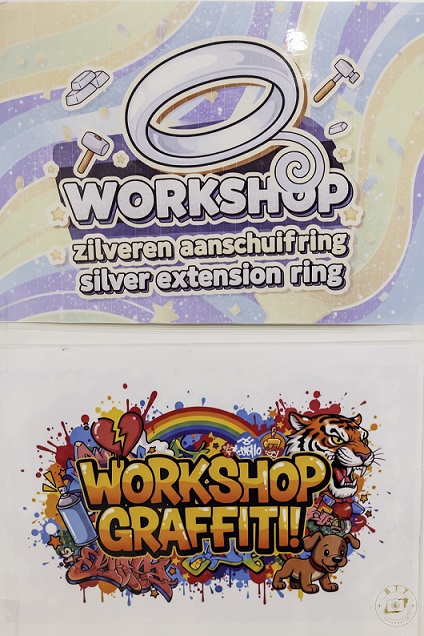

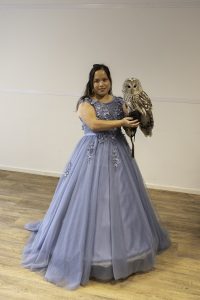 Photoshoot
Photoshoot

